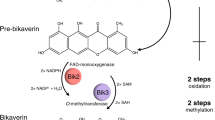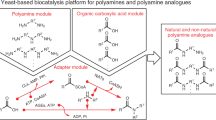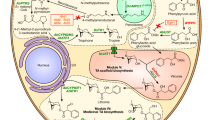Abstract
Malaria is a global health problem that threatens 300–500 million people and kills more than one million people annually1. Disease control is hampered by the occurrence of multi-drug-resistant strains of the malaria parasite Plasmodium falciparum2,3. Synthetic antimalarial drugs and malarial vaccines are currently being developed, but their efficacy against malaria awaits rigorous clinical testing4,5. Artemisinin, a sesquiterpene lactone endoperoxide extracted from Artemisia annua L (family Asteraceae; commonly known as sweet wormwood), is highly effective against multi-drug-resistant Plasmodium spp., but is in short supply and unaffordable to most malaria sufferers6. Although total synthesis of artemisinin is difficult and costly7, the semi-synthesis of artemisinin or any derivative from microbially sourced artemisinic acid, its immediate precursor, could be a cost-effective, environmentally friendly, high-quality and reliable source of artemisinin8,9. Here we report the engineering of Saccharomyces cerevisiae to produce high titres (up to 100 mg l-1) of artemisinic acid using an engineered mevalonate pathway, amorphadiene synthase, and a novel cytochrome P450 monooxygenase (CYP71AV1) from A. annua that performs a three-step oxidation of amorpha-4,11-diene to artemisinic acid. The synthesized artemisinic acid is transported out and retained on the outside of the engineered yeast, meaning that a simple and inexpensive purification process can be used to obtain the desired product. Although the engineered yeast is already capable of producing artemisinic acid at a significantly higher specific productivity than A. annua, yield optimization and industrial scale-up will be required to raise artemisinic acid production to a level high enough to reduce artemisinin combination therapies to significantly below their current prices.
This is a preview of subscription content, access via your institution
Access options
Subscribe to this journal
Receive 51 print issues and online access
$199.00 per year
only $3.90 per issue
Buy this article
- Purchase on Springer Link
- Instant access to full article PDF
Prices may be subject to local taxes which are calculated during checkout




Similar content being viewed by others
References
World Health Organization. World Malaria Report 2005. (WHO, Geneva, 2005)
Korenromp, E. L., Williams, B. G., Gouws, E., Dye, C. & Snow, R. W. Measurement of trends in childhood malaria mortality in Africa: An assessment of progress toward targets based on verbal autopsy. Lancet Infect. Dis. 3, 349–358 (2003)
Marsh, K. Malaria disaster in Africa. Lancet 352, 924 (1998)
Hoffman, S. Save the children. Nature 430, 940–941 (2004)
Vennerstrom, J. L. et al. Identification of an antimalarial synthetic trioxolane drug development candidate. Nature 430, 900–904 (2004)
Enserink, M. Infectious diseases: Source of new hope against malaria is in short supply. Science 307, 33 (2005)
Schmid, G. & Hofheinz, W. Total synthesis of Qinghaosu. J. Am. Chem. Soc. 105, 624–625 (1983)
Acton, N. & Roth, R. J. On the conversion of dihydroartemisinic acid into artemisinin. J. Org. Chem. 57, 3610–3614 (1992)
Haynes, R. K. & Vonwiller, S. C. Cyclic peroxyacetal lactone, lactol and ether compounds. US patent 5,310,946 (1994).
Mercke, P., Bengtsson, M., Bouwmeester, H. J., Posthumus, M. A. & Brodelius, P. E. Molecular cloning, expression, and characterization of amorpha-4,11-diene synthase, a key enzyme of artemisinin biosynthesis in Artemisia annua L. Arch. Biochem. Biophys. 381, 173–180 (2000)
Martin, V. J., Pitera, D. J., Withers, S. T., Newman, J. D. & Keasling, J. D. Engineering a mevalonate pathway in Escherichia coli for production of terpenoids. Nature Biotechnol. 21, 796–802 (2003)
Donald, K., Hampton, R. & Fritz, I. Effects of overproduction of the catalytic domain of 3-hydroxy-3-methylglutaryl coenzyme A reductase on squalene synthesis in Saccharomyces cerevisiae. Appl. Environ. Microbiol. 63, 3341–3344 (1997)
Gardner, R. G. & Hampton, R. Y. A highly conserved signal controls degradation of 3-hydroxy-3-methylglutaryl-coenzyme A (HMG-CoA) reductase in eukaryotes. J. Biol. Chem. 274, 31671–31678 (1999)
Davies, B. S. J., Wang, H. S. & Rine, J. Dual activators of the sterol biosynthetic pathway of Saccharomyces cerevisiae: Similar activation/regulatory domains but different response mechanisms. Mol. Cell. Biol. 25, 7375–7385 (2005)
Jackson, B. E., Hart-Wells, E. A. & Matsuda, S. P. T. Metabolic engineering to produce sesquiterpenes in yeast. Org. Lett. 5, 1629–1632 (2003)
Seaman, F. C. Sesquiterpene lactones as taxonomic characters in the Asteraceae. Bot. Rev. 48, 121–592 (1982)
Bertea, C. M. et al. Identification of intermediates and enzymes involved in the early steps of artemisinin biosynthesis in Artemisia annua. Planta Med. 71, 40–47 (2005)
Altschul, S. F., Gish, W., Miller, W., Myers, E. W. & Lipman, D. J. Basic local alignment search tool. J. Mol. Biol. 215, 403–410 (1990)
Lupien, S., Karp, F., Wildung, M. & Croteau, R. Regiospecific cytochrome P450 limonene hydroxylases from mint (Mentha) species: cDNA isolation, characterization, and functional expression of (- )-4S-limonene-3-hydroxylase and (- )-4S-limonene-6-hydroxylase. Arch. Biochem. Biophys. 368, 181–192 (1999)
Ralston, L. et al. Cloning, heterologous expression, and functional characterization of 5-epi-aristolochene-1,3-dihydroxylase from tobacco (Nicotiana tabacum). Arch. Biochem. Biophys. 393, 222–235 (2001)
Wang, E. et al. Suppression of a P450 hydroxylase gene in plant trichome glands enhances natural-product-based aphid resistance. Nature Biotechnol. 19, 371–374 (2001)
Elmarakby, S. A., El-Feraly, F. S., Elsohly, H. N., Croom, E. M. & Hufford, C. D. Microbiological transformations of artemisinic acid. Phytochemistry 27, 3089–3091 (1988)
Kim, S., Han, J. & Lim, Y. Revised assignment of 1H-NMR signals of artemisinic acid. Planta Med. 62, 480–481 (1996)
Helliwell, C. A., Poole, A., Peacock, W. J. & Dennis, E. S. Arabidopsis ent-kaurene oxidase catalyzes three steps of gibberellin biosynthesis. Plant Physiol. 119, 507–510 (1999)
Helliwell, C. A., Chandler, P. M., Poole, A., Dennis, E. S. & Peacock, W. J. The CYP88A cytochrome P450, ent-kaurenoic acid oxidase, catalyzes three steps of the gibberellin biosynthesis pathway. Proc. Natl Acad. Sci. USA 98, 2065–2070 (2001)
Pompon, D., Louerat, B., Bronine, A. & Urban, P. Yeast expression of animal and plant P450s in optimized redox environments. Methods Enzymol. 272, 51–64 (1996)
Acknowledgements
We thank D. Nelson for assigning an official CYP number, and D. Ockey and D. McPhee for artemisinic acid isolation from the A. annua plant. We are also grateful to N. A. Da Silva for pδ-UB, R. Y. Hampton for pRH127-3 and pRH973, and J. Rine for pBD33 and pBD36. We thank R. Michelmore and other members in the Compositae Genomics Project for the support of this project. This research was conducted under the sponsorship of the Institute for OneWorld Health, through the generous support of The Bill and Melinda Gates Foundation, and through funding from the Akibene Foundation, the United States Department of Agriculture, a University of California Discovery Grant, the Diversa Corporation and the National Science Foundation. Author Contributions D.-K.R., E.M.P. and J.D.K. designed the project and experiments. D.-K.R., E.M.P., Y.S., M.C.Y.C., S.T.W. and J.K. performed experiments. K.J.F. conducted NMR analysis of artemisinic acid. J.M.N. and R.S. semi-synthesized artemisinic alcohol and artemisinic aldehyde. T.S.H. performed bioinformatics analysis of the Compositae EST-database. M.O., R.A.E. and K.A.H. provided technical assistance. D.-K.R., E.M.P., K.L.N. and J.D.K. wrote the paper. All authors discussed the results and commented on the manuscript.
Author information
Authors and Affiliations
Corresponding author
Ethics declarations
Competing interests
J.D.K. is a founder of Amyris Biotechnologies, a company that may eventually use the genes and yeast strains described in this paper for the production of artemisinin. However, neither Amyris Biotechnologies nor the University of California will make any profit from the production and sale of the antimalarial drug artemisinin.
Supplementary information
Supplementary Data
This file contains Supplementary Figure 1, Supplementary Methods, Supplementary Discussion, and Supplementary Tables I, II and III. (DOC 98 kb)
Rights and permissions
About this article
Cite this article
Ro, DK., Paradise, E., Ouellet, M. et al. Production of the antimalarial drug precursor artemisinic acid in engineered yeast. Nature 440, 940–943 (2006). https://doi.org/10.1038/nature04640
Received:
Accepted:
Issue Date:
DOI: https://doi.org/10.1038/nature04640
This article is cited by
-
From beer to breadboards: yeast as a force for biological innovation
Genome Biology (2024)
-
The forefront of chemical engineering research
Nature Chemical Engineering (2024)
-
Metabolic engineering of plant medicines
Nature Reviews Genetics (2024)
-
Iron oxide nanoparticles (Fe3O4-NPs) elicited Artemisia annua L. in vitro, toward enhancing artemisinin production through overexpression of key genes in the terpenoids biosynthetic pathway and induction of oxidative stress
Plant Cell, Tissue and Organ Culture (PCTOC) (2024)
-
The logic of carbon substitution: from fossilised life to “cell factories”
Review of Agricultural, Food and Environmental Studies (2024)
Comments
By submitting a comment you agree to abide by our Terms and Community Guidelines. If you find something abusive or that does not comply with our terms or guidelines please flag it as inappropriate.



